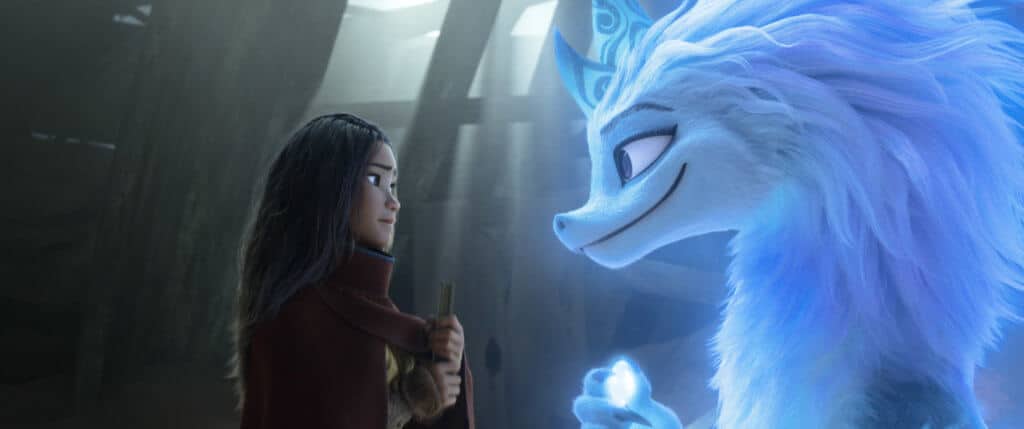Raya seeks the help of the legendary dragon, Sisu. “Raya and the Last Dragon” © 2021 Disney. All Rights Reserved.
As a gay, mixed East and Southeast Asian woman, growing up, representation was far and few between. I loved Disney princesses, but for years rejected Mulan because I felt pigeon-holed into believing she was the only one I could relate to. Even now, finding that intersectional representation is practically impossible. How much is Disney’s newest Disney princess movie, Raya and the Last Dragon, falling on the heels of that buzzword of representation, and how successfully does it fulfill that?
Between Princess and the Frog, Moana, and the Mulan and Aladdin live action remakes, Disney has been trying to invigorate their Disney princess line with promises of diversity, and Raya is no exception, being celebrated as the first Southeast Asian Disney princess. However, how well does it really give representation to Southeast Asians?
Cultural signifiers and inspiration in Raya come from Cambodia, Laos, Thailand, Vietnam, Singapore, Indonesia, the Philippines, Myanmar, and Malaysia. It’s in the food, the music, costuming, naming, props and set dressing, and some of the actions of the characters. However, for all of the bits and pieces that are scattered, like a treasure hunt throughout the film, it also shapes them into an unidentifiable monolith, an ignorance of the separate facets of each of these cultures.
The film is able to do this with the fictional setting of Kumandra, which does not correspond to any one real country. It reminded me, in certain ways, of Avatar: The Last Airbender, which, although drew inspiration for each nation from a certain culture, melded them and often mixed them up, hidden by the fact that they were the four nations of Earth, Air, Fire and Water and not their counterparts of China, Tibet, Japan, and Inuit. There were mistakes, often in set dressing, such as Chinese props used in the Japan-inspired China. Additionally, although Avatar was seen as a hallmark in diversity in kids shows and is beloved by many who belong to the groups represented, the showcase of culture, similar to Raya, is superficial. Though there are elements present, the stories are still created for primarily white audiences.
There has also been the criticism of the lack of representation of the side of cast and creative team. Although Raya had two Southeast Asian writers—Malaysian-born script writer Adele Kim, and Vietnamese screenwriter Qui Nguyen—both of the directors are white, and therefore shape the way the story is told. The ignorance of difference between East Asia and Southeast Asia is also one that has been brought up surrounding Raya. There’s often a complete lack of attention given to Southeast Asia, the “jungle Asians” to East Asia’s “fancy Asians,” as described by comedian Ali Wong. Southeast Asia is often seen as more primitive, less cultured, and therefore less represented, especially in Western media. I’ve even experienced this in my own family, as, though my mother’s side of the family has connections to the Philippines and my father’s has Thai and Malaysian roots, beyond food we ignore it, keeping only the identifier that we’re Chinese.
On one hand, it’s easier to explain. On the other, it’s a complete removal of ties to a “less cultured side,” and something I struggle with regularly. Raya’s cast stars Kelly Marie Tran as Raya, however, she’s the only Southeast Asian in the cast with a prominent speaking role. The main cast is instead filled with famous East Asian celebrities, particularly Korean and Chinese, such as Awkwafina, Daniel Dae Kim, Gemma Chan, and Sandra Oh. To further twist in the knife, Disney+ is barely available in Southeast Asia: only in Indonesia and Singapore, although there are plans to expand into Malaysia, the Philippines, and Thailand later this year. It further solidifies that Raya is not Southeast Asia for Southeast Asians, but for an American audience.
Despite the troubles in the casting, Raya also makes strides, without being too loud or over-celebratory about it. In recent years, Disney has been scrutinized for its poor gay representation, from the hype over the Beauty and the Beast remake’s “first gay character” amounting to being barely present, to Onward’s gay troll cop (sigh). However, in subtext, Raya has managed some incredible steps forward. Although it’s in a minor role, and only for a few lines close to the beginning of the movie, Raya features Patti Harrison, the first out trans actor to voice a Disney character. Additionally, audiences have been seeing the tensions between the main characters of Raya and Namaari, and in a Vanity Fair interview, Kelly Marie Tran agreed. She said that her interpretation had “some romantic feelings going on there,” and that “if you’re a person watching this movie and you see representation in a way that feels real and authentic to you, then it is real and authentic.”
Although I don’t see Disney confirming this anytime soon, having the actress who played the character say it, to me, makes it enough for me. I also think that Tran’s words can be used to encapsulate my feelings on the movie’s dealing with representation as a whole. I’ll critique and recognize the mistakes made, however, for me, Raya is the gay Southeast Asian Disney Princess that seven-year-old me was waiting for.






